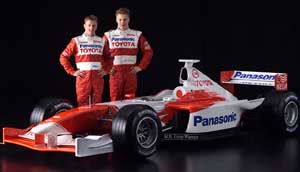DECEMBER 17, 2001
Panasonic Toyota F1 team unveils race car for 2002

Toyota's F1 operation is the only team apart from Ferrari to produce its own chassis and engine under one roof, and is the first new entrant to do so since 1979. It is also the first Japanese manufacturer to compete in its own right since 1968, the final season of the Honda F1 works effort which had John Surtees as its lead driver.
Panasonic Toyota Racing's F1 car, TF102, is a successor to the team's 2001 test car, TF101, and comes with a brand new livery. The car retains Toyota's corporate colors of red and white, while additionally carrying the logos of the team's newly acquired partners AOL Time Warner and Wella. The new car has been designed by a team led by Chief Designer Gustav Brunner, who joined Toyota in May, and overseen by Technical Manager of the chassis department, Dago R?hrer. The 2002 contender incorporates the lessons learned from this season's intensive testing program.
"The car we tested in 2001 was designed to be a test car and nothing more," says Brunner. "It served that purpose very well. The 2002 race car is a more conventional but state-of-the-art car. Even though our design and build time was very short we still managed to meet our deadlines and create the new car in time."
The engine program is managed by Norbert Kreyer, who has had the job of designing and developing the Toyota V10 from scratch. The 2002 race car is powered by newly developed engine, RVX-02.
Since the launch of its test car in March 2001, the team has visited 11 of the current F1 venues worldwide, in addition to Toyota's home testing base at Paul Ricard in France. In the eight-month period to November 2001, the test cars had clocked up 20,967 kilometers or over 3,000 laps. Tsutomu Tomita, Chairman of Toyota Motorsport and Managing Director of Toyota Motor Corporation in Japan, said: "We are extremely pleased to make Toyota's first ever race car debut today. Though we have only just climbed over one of many hurdles we will face during our F1 challenge, we want to share the joy and excitement of the completion of the car with all of our partners and Toyota members. We are committed to challenging in F1 with determination. Through our endeavor, we wish to convey the excitement of Formula 1 races to the fans around the globe."
Toyota Motorsport President Ove Andersson is also extremely proud of the job everyone in the organization has achieved as it prepares for the enormous challenge that F1 represents.
"I think our main target for next year will be to learn, and to try to gain respect within the F1 paddock," says Andersson. "We want to be a team that at the end of next year everybody will say, 'They came, and we think they did a reasonable job.' That's my target for the first year."
In 2002, Panasonic Toyota Racing will test with the new TF102, initially at Circuit Paul Ricard. The team also plans to participate in a joint test scheduled in Barcelona and will have its very first run with other teams.
Intensive testing will resume in January 2002 with drivers Mika Salo and Allan McNish. The team is also in the process of finding test drivers to support Mika and Allan. Panasonic Toyota Racing will announce its test drivers as and when a contract is made.
Toyota's Young Drivers' Program also emphasizes that the team also has an eye on the future. Led by team manager Ange Pasquali, its first beneficiaries are Australian Ryan Briscoe (20) and Frenchman Franck Perera (17) who have been contracted to the scheme since early 2001. A third young driver, Swedish-born Alexander Storckenfeldt (17), was additionally signed up in December to join the initiative. The careers of all three rising stars will be supported by Toyota to higher motor racing formulae.
Toyota Motorsport has been based in Cologne since 1979, and the facility was formerly the site of the company's World Rally Championship and Le Mans programs. It is the only F1 team to be based in and to build an entire car in Germany.
The team's base was recently expanded from 18,000 to 30,000 square meters as the F1 project got into gear and now incorporates the most sophisticated equipment available, which allows the team to build and develop the majority of things in-house. The floor space is split 60:40 between the chassis and engine departments. Calibration of the on-site wind tunnel is drawing to a close, and it should be up and running early in 2002.
Although the F1 program is based in Germany, the team has access to Toyota's extensive R&D facilities in Japan, and there is a continuous flow of information.
Just two and a half months remain until the opening race of the season, and it will be an extremely busy period as the test program with the TF102 gets underway. However, all in the team are looking forward to the challenge of the first race weekend in Australia.
"It is a big task, yes, but we are not that much worried," says Ove Andersson. "We have been reasonably on schedule with whatever we've done up to now. I am now looking forward to testing the new car and to lining up on the grid in Melbourne for Toyota's first ever Grand Prix weekend."